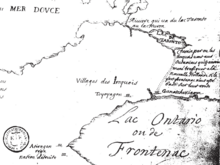Rouge, Toronto
Rouge | |
|---|---|
Neighbourhood | |
L) | |
| • Councillor | Vacant |
| Population | |
| • Total | 102,275 |
Rouge is a neighbourhood in the northeastern area of
Location

It is bounded on the north by
It is one of the largest neighbourhoods officially recognized by the City of Toronto, and is dominated by the Rouge River, its tributaries, and associated wilderness areas. North of Sheppard Avenue the neighbourhood has a strong suburban quality, with seventy-four percent of households single-family residences.
Beyond its official categorization, Rouge can be subdivided into smaller neighbourhoods more commonly known as Dean Park, Rouge Hill, Hillside, and West Rouge, among others.
History

The area situated along the Rouge River was considered a part of the Toronto Carrying-Place Trail, a portaging route to the Holland River, linking Lake Ontario to Lake Simcoe. This route was used by the indigenous peoples, and later by European traders, explorers and settlers.
The Seneca people established the village of Ganatsekwyagon in the area that presently makes up the neighbourhood. However, the settlement was abandoned by the end of the 17th century, as a result of the Beaver Wars. Presently referred to as Bead Hill, the area is an archaeological site comprising the only known remaining and intact 17th-century Seneca site in Canada. It was designated a National Historic Site of Canada in 1991.[1]
Education
Two
TCDSB operates two public elementary schools, St. Dominic Savio Catholic School, and St. Jean De Brebeuf Catholic School. TDSB operates four public elementary schools in Rouge, Alvin Curling Public School, Chief Dan George Public School, John G. Diefenbaker Public School, and Rouge Valley Public School
Neither school board operates a secondary school in the neighbourhood, with TCDSB/TDSB secondary school students residing in Rouge attending institutions in adjacent neighbourhoods. The French-based public secular school board, Conseil scolaire Viamonde, and it separate counterpart, Conseil scolaire catholique MonAvenir also offer schooling to applicable residents of Morningside, although they do not operate a school in the neighbourhood, with CSCM/CSV students attending schools situated in other neighbourhoods in Toronto.
Recreation
The neighbourhood is home to several municipal parks near the Rouge River ravine system, including Bob Hunter Park, Adams Park and Dean Park. Municipal parks in Rouge are managed by the Toronto Parks, Forestry and Recreation Division. In addition to municipal parks, the City of Toronto also manages the Toronto Zoo, a zoo located within the neighbourhood.
See also
References
- ^ "Bead Hill National Historic Site of Canada". Parks Canada. Retrieved 2 February 2014.
